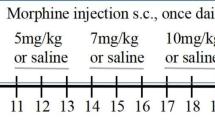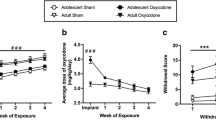Abstract
Rationale
The use and misuse of prescription opiates in adolescent populations, and in particular, adolescent female populations, has increased dramatically in the past two decades. Given the significant role that opioids play in neuroendocrine function, exposure to opiates during this critical developmental period could have significant consequences for the female, as well as her offspring.
Objectives
In the current set of studies, we utilized the female rat to model the transgenerational impact of adolescent opiate exposure.
Methods
We examined locomotor sensitization in response to the dopamine D2/D3 receptor agonist quinpirole in the adult male progeny (F1 and F2 generations) of females exposed to morphine during adolescence. All females were drug-free for at least 3 weeks prior to conception, eliminating the possibility of direct fetal exposure to morphine.
Results
Both F1 and F2 progeny of morphine-exposed females demonstrated attenuated locomotor sensitization following repeated quinpirole administration. These behavioral effects were coupled with increased quinpirole-induced corticosterone secretion and upregulated kappa opioid receptor and dopamine D2 receptor (D2R) gene expression within the nucleus accumbens.
Conclusions
These results suggest significant modifications in response to repeated D2R activation in the progeny of females exposed to opiates during adolescence. Given the significant role that the D2R plays in psychopathology, adolescent opiate exposure could shift the vulnerability of future offspring to psychological disorders, including addiction. Moreover, that effects are also observed in the F2 generation suggests that adolescent opiate exposure can trigger transgenerational epigenetic modifications impacting systems critical for motivated behavior.





Similar content being viewed by others
References
Becker JB, Hu M (2008) Sex differences in drug abuse. Front Neuroendocrinol 29:36–47
Byrnes EM (2005a) Chronic morphine exposure during puberty decreases postpartum prolactin secretion in adult female rats. Pharmacol Biochem Behav 80:445–451
Byrnes EM (2005b) Transgenerational consequences of adolescent morphine exposure in female rats: effects on anxiety-like behaviors and morphine sensitization in adult offspring. Psychopharmacol (Berl) 182:537–544
Byrnes EM (2008) Chronic morphine exposure during puberty induces long-lasting changes in opioid-related mRNA expression in the mediobasal hypothalamus. Brain Res 1190:186–192
Byrnes JJ, Babb JA, Scanlan VF, Byrnes EM (2011) Adolescent opioid exposure in female rats: transgenerational effects on morphine analgesia and anxiety-like behavior in adult offspring. Behav Brain Res 218:200–205
Carpenter TL, Pazdernik TL, Levant B (2003) Differences in quinpirole-induced local cerebral glucose utilization between naive and sensitized rats. Brain Res 964:295–301
Crews D, Gore AC, Hsu TS, Dangleben NL, Spinetta M, Schallert T, Anway MD, Skinner MK (2007) Transgenerational epigenetic imprints on mate preference. Proc Natl Acad Sci U S A 104:5942–5946
Culver KE, Szechtman H (2004) Hypophysectomy does not block sensitization to the dopamine agonist quinpirole or its modulation by the MAOI clorgyline. Horm Behav 45:23–30
Cummings JA, Clemens LG, Nunez AA (2010) Mother counts: how effects of environmental contaminants on maternal care could affect the offspring and future generations. Front Neuroendocrinol 31:440–451
de Haas R, Nijdam A, Westra TA, Kas MJ, Westenberg HG (2011) Behavioral pattern analysis and dopamine release in quinpirole-induced repetitive behavior in rats. J Psychopharmacol 25:1712–1719
de Jong IE, Steenbergen PJ, de Kloet ER (2009) Behavioral sensitization to cocaine: cooperation between glucocorticoids and epinephrine. Psychopharmacol (Berl) 204:693–703
Dreher JK, Jackson DM (1989) Role of D1 and D2 dopamine receptors in mediating locomotor activity elicited from the nucleus accumbens of rats. Brain Res 487:267–277
Einat H, Einat D, Allan M, Talangbayan H, Tsafnat T, Szechtman H (1996) Associational and nonassociational mechanisms in locomotor sensitization to the dopamine agonist quinpirole. Psychopharmacol (Berl) 127:95–101
Fattore L, Altea S, Fratta W (2008) Sex differences in drug addiction: a review of animal and human studies. Womens Health (Lond Engl) 4:51–65
Frese WA, Eiden K (2011) Opioids: nonmedical use and abuse in older children. Pediatr Rev 32:e44–e52
Henry DJ, Hu XT, White FJ (1998) Adaptations in the mesoaccumbens dopamine system resulting from repeated administration of dopamine D1 and D2 receptor-selective agonists: relevance to cocaine sensitization. Psychopharmacol (Berl) 140:233–242
Ho DH, Burggren WW (2010) Epigenetics and transgenerational transfer: a physiological perspective. J Exp Biol 213:3–16
Hummel M, Unterwald EM (2002) D1 dopamine receptor: a putative neurochemical and behavioral link to cocaine action. J Cell Physiol 191:17–27
Ikemoto S, Goeders NE (1998) Microinjections of dopamine agonists and cocaine elevate plasma corticosterone: dissociation effects among the ventral and dorsal striatum and medial prefrontal cortex. Brain Res 814:171–178
Johnson NL, Carini L, Schenk ME, Stewart M, Byrnes EM (2011) Adolescent opiate exposure in the female rat induces subtle alterations in maternal care and transgenerational effects on play behavior. Front Psychiatry 2:29
Koeltzow TE, Austin JD, Vezina P (2003) Behavioral sensitization to quinpirole is not associated with increased nucleus accumbens dopamine overflow. Neuropharmacology 44:102–110
Marinelli M, Piazza PV (2002) Interaction between glucocorticoid hormones, stress and psychostimulant drugs. Eur J Neurosci 16:387–394
Meriney SD, Ford MJ, Oliva D, Pilar G (1991) Endogenous opioids modulate neuronal survival in the developing avian ciliary ganglion. J Neurosci 11:3705–3717
Ortiz J, DeCaprio JL, Kosten TA, Nestler EJ (1995) Strain-selective effects of corticosterone on locomotor sensitization to cocaine and on levels of tyrosine hydroxylase and glucocorticoid receptor in the ventral tegmental area. Neuroscience 67:383–397
Perreault ML, Graham D, Bisnaire L, Simms J, Hayton S, Szechtman H (2006) Kappa-opioid agonist U69593 potentiates locomotor sensitization to the D2/D3 agonist quinpirole: pre- and postsynaptic mechanisms. Neuropsychopharmacology 31:1967–1981
Perreault ML, Graham D, Scattolon S, Wang Y, Szechtman H, Foster JA (2007a) Cotreatment with the kappa opioid agonist U69593 enhances locomotor sensitization to the D2/D3 dopamine agonist quinpirole and alters dopamine D2 receptor and prodynorphin mRNA expression in rats. Psychopharmacol (Berl) 194:485–496
Perreault ML, Seeman P, Szechtman H (2007b) Kappa-opioid receptor stimulation quickens pathogenesis of compulsive checking in the quinpirole sensitization model of obsessive-compulsive disorder (OCD). Behav Neurosci 121:976–991
Pfaffl MW (2001) A new mathematical model for relative quantification in real-time RT-PCR. Nucleic Acids Res 29:e45
Phillips GD, Howes SR, Whitelaw RB, Robbins TW, Everitt BJ (1995) Analysis of the effects of intra-accumbens SKF-38393 and LY-171555 upon the behavioural satiety sequence. Psychopharmacol (Berl) 117:82–90
Prasad BM, Ulibarri C, Kalivas PW, Sorg BA (1996) Effect of adrenalectomy on the initiation and expression of cocaine-induced sensitization. Psychopharmacol (Berl) 125:265–273
Rowlett JK, Mattingly BA, Bardo MT (1995) Repeated quinpirole treatment: locomotor activity, dopamine synthesis, and effects of selective dopamine antagonists. Synapse 20:209–216
SAMHSA (2011) Results from the 2010 National Survey on Drug Use and Health: summary of national findings. Substance Abuse and Mental Health Services Administration, NSDUH Series H-41 HHS Publication No. (SMA) 11-4658
Schmidt ED, Tilders FJ, Binnekade R, Schoffelmeer AN, De Vries TJ (1999) Stressor- or drug-induced sensitization of the corticosterone response is not critically involved in the long-term expression of behavioural sensitization to amphetamine. Neuroscience 92:343–352
Steiner H, Gerfen CR (1996) Dynorphin regulates D1 dopamine receptor-mediated responses in the striatum: relative contributions of pre- and postsynaptic mechanisms in dorsal and ventral striatum demonstrated by altered immediate-early gene induction. J Comp Neurol 376:530–541
Steketee JD, Kalivas PW (2011) Drug wanting: behavioral sensitization and relapse to drug-seeking behavior. Pharmacol Rev 63:348–365
Steketee JD, Sorg BA, Kalivas PW (1992) The role of the nucleus accumbens in sensitization to drugs of abuse. Prog Neuropsychopharmacol Biol Psychiatry 16:237–246
Szechtman H, Talangbayan H, Eilam D (1993) Environmental and behavioral components of sensitization induced by the dopamine agonist quinpirole. Behav Pharmacol 4:405–410
Szumlinski KK, Allan M, Talangbayan H, Tracey A, Szechtman H (1997) Locomotor sensitization to quinpirole: environment-modulated increase in efficacy and context-dependent increase in potency. Psychopharmacol (Berl) 134:193–200
Szumlinski KK, Goodwill AM, Szechtman H (2000) Locomotor sensitization to quinpirole in rats: effects of drug abstinence and sex. Psychopharmacol (Berl) 152:304–311
Taepavarapruk P, Floresco SB, Phillips AG (2000) Hyperlocomotion and increased dopamine efflux in the rat nucleus accumbens evoked by electrical stimulation of the ventral subiculum: role of ionotropic glutamate and dopamine D1 receptors. Psychopharmacol (Berl) 151:242–251
Vanderschuren LJ, Kalivas PW (2000) Alterations in dopaminergic and glutamatergic transmission in the induction and expression of behavioral sensitization: a critical review of preclinical studies. Psychopharmacol (Berl) 151:99–120
Vernadakis A, Sakellaridis N, Geladopoulos T, Mangoura D (1990) Function of opioids early in embryogenesis. Ann N Y Acad Sci 579:109–122
Wise RA, Leeb K (1993) Psychomotor-stimulant sensitization: a unitary phenomenon? Behav Pharmacol 4:339–349
Wrobel A, Zebrowska-Lupina I, Wielosz M (2005) Dexamethasone reduces locomotor stimulation induced by dopamine agonists in mice. Pharmacol Rep 57:451–457
Wu M, Brudzynski SM, Mogenson GJ (1993) Differential effects of quinpirole in the nucleus accumbens depending on the initial level of locomotor activity. Brain Res Bull 32:395–398
Zagon IS, Tobias SW, McLaughlin PJ (1997) Endogenous opioids and prenatal determinants of neuroplasticity. Adv Exp Med Biol 429:289–303
Zagon IS, Wu Y, McLaughlin PJ (1999) Opioid growth factor and organ development in rat and human embryos. Brain Res 839:313–322
Acknowledgments
This work was supported by NIH R01DA25674 (EMB).
Conflict of interest
All authors declare that, except for income received from our primary employer, no financial support or compensation has been received from any individual or corporate entity for this research or related professional service. There are no personal financial holdings that could be perceived as constituting a potential conflict of interest. The authors have full control of all primary data and that they agree to allow the journal to review their data if requested.
Author information
Authors and Affiliations
Corresponding author
Rights and permissions
About this article
Cite this article
Byrnes, J.J., Johnson, N.L., Carini, L.M. et al. Multigenerational effects of adolescent morphine exposure on dopamine D2 receptor function. Psychopharmacology 227, 263–272 (2013). https://doi.org/10.1007/s00213-012-2960-1
Received:
Accepted:
Published:
Issue Date:
DOI: https://doi.org/10.1007/s00213-012-2960-1




